|
|
|
Sort Order |
|
|
|
Items / Page
|
|
|
|
|
|
|
| Srl | Item |
| 1 |
ID:
148222
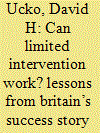

|
|
|
|
|
| Summary/Abstract |
Following frustrating campaigns in Iraq and Afghanistan, Western interventions are becoming more limited, with troops being deployed for short bursts and residual peace-building tasks being left to others. Although this approach limits exposure for the intervening government, it struggles to achieve meaningful political change. Examining the comparatively successful British intervention in Sierra Leone (2000–02), this article identifies the conditions for effectiveness in these campaigns. It challenges the historiography of the case by framing armed confrontations and raids as enablers of politics rather than ends in themselves; indeed, in both the conduct and study of intervention, politics must reign supreme.
|
|
|
|
|
|
|
|
|
|
|
|
|
|
|
|
| 2 |
ID:
148224
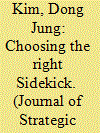

|
|
|
|
|
| Summary/Abstract |
Scholars and practitioners of grand strategy agree that the use of military force should be supplemented by appropriate economic policies. However, strangely few accounts of economic complements to military grand strategies have been presented in recent discourse on US grand strategy. This paper takes a first step to fill this information gap. I first assess the role that could be played by economic measures under two types of grand strategies – one focusing on the balance of power and the other emphasising influence and order. Second, I introduce what I call ‘the influence-capability dilemma’ and discuss tradeoffs in adopting certain economic policies in order to help the US sustain pre-eminence in the international system. Third, I discuss how the US should address this dilemma of economic means in dealing with the rising China.
|
|
|
|
|
|
|
|
|
|
|
|
|
|
|
|
| 3 |
ID:
148223
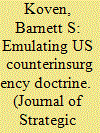

|
|
|
|
|
| Summary/Abstract |
Recent US advances in counterinsurgency doctrine have been adopted by developing country armed forces. Nevertheless, no systematic study has examined the barriers they face to implementing highly involved counterinsurgency strategy. Tracing the evolution of Peruvian doctrine demonstrates that Peru was able to quickly improve the unity of effort, intelligence capacity, and military basing to meet the demands of a population-centric hearts-and-minds approach to counterinsurgency. Nevertheless, the limited tactical initiative and flexibility of Peruvian forces remains a challenge. The Peruvian experience is instructive for other militaries undergoing similar transitions. However, given the diversity of insurgent conflicts, this doctrine is not universally appropriate.
|
|
|
|
|
|
|
|
|
|
|
|
|
|
|
|
| 4 |
ID:
148221
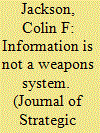

|
|
|
|
|
| Summary/Abstract |
While many militaries have tried to capitalize on the potential of information operations in internal war, few have succeeded. I argue that military information campaigns fall short of expectations for two reasons. First, the theory of influence militaries generally embrace – communications as a non-lethal weapons system – is largely invalid. While treating information as a weapons system makes it easier to integrate it into the existing military planning system, this overstates the independent effects of communications on behavior and understates the importance of interactive effects of what commercial marketing theory refers to as the “marketing mix” – product, price, promotion, and placement. It would be more appropriate to treat military information operations as a form of marketing: a composite effort to induce a specific behavior in a target audience by applying a combination of material and ideational instruments. The marketing model suggests that the efficacy of information operations will depend not simply on the message and its delivery (promotion) but on the behavior the sender seeks to induce (the product), the costs of that behavior (the price), and the opportunities available for such behavior (the placement).
|
|
|
|
|
|
|
|
|
|
|
|
|
|
|
|
| 5 |
ID:
148218
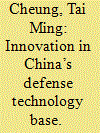

|
|
|
|
|
| Summary/Abstract |
China’s defense science, technology, and industrial system has been undergoing a far-reaching transformation over the past two decades and the single biggest factor behind this turnaround is the role of external technology and knowledge transfers and the defense industry’s improving ability to absorb these inputs and convert into localized output. China is pursuing an intensive campaign to obtain defense and dual-use civil–military foreign technology transfers using a wide variety of means, which is explored in this article.
|
|
|
|
|
|
|
|
|
|
|
|
|
|
|
|
| 6 |
ID:
148216
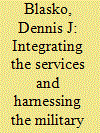

|
|
|
|
|
| Summary/Abstract |
The Chinese People’s Liberation Army (PLA) is halfway through a multi-decade modernization process. It has begun a major restructuring effort as it shifts its focus from a traditional continental defensive posture to a more maritime-oriented emphasis. In order to create more balanced joint force, it has adjusted the structure of its highest command organization, the Central Military Commission; abolished the former four General Departments and seven Military Regions; created five new joint Theater Commands and service-level commands for the Army and Rocket Force; and is reducing the size of its active duty force by 300,000 personnel. While seeking to overcome numerous internal obstacles, the PLA continues to develop and improve its capabilities to conduct integrated joint operations to deter a variety of threats to China’s sovereignty and territory and, if deterrence fails, to win informationized local war.
|
|
|
|
|
|
|
|
|
|
|
|
|
|
|
|
| 7 |
ID:
148213


|
|
|
|
|
| Summary/Abstract |
Since emerging as China’s top leader following the 18th Party Congress, Xi Jinping has moved swiftly to consolidate his formal authority as Central Military Commission chairman over the Chinese People’s Liberation Army. In redressing the civil-military imbalance wrought by Dengist economic reforms, the commander-in-chief has combined institutional mechanisms with the use of fear to impose authoritative civilian control over the military. This paper proposes that a combination of changes to the Chinese strategic environment has contributed to Xi’s utility of the anti-corruption campaign to purge the regime’s coercive forces of its previous underpinnings, and advances that the war on military malfeasance has given rise to a new set of dynamics in civil-military relations in post-Reform China.
|
|
|
|
|
|
|
|
|
|
|
|
|
|
|
|
| 8 |
ID:
148219
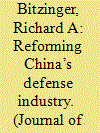

|
|
|
|
|
| Summary/Abstract |
Even with sizable economic inputs, access to foreign technologies, and considerable political will, China, up until the late 1990s, experienced only limited success when it came to the local design, development, and manufacture of advanced conventional weapons. Not surprisingly, therefore, reforming the local defense industry in order to upgrade its technology base and manufacturing capabilities and to make armaments production more efficient and cost-effective has long preoccupied the Chinese leadership. The fact that most of these efforts had little positive impact on the country’s military technological and industrial capabilities only encouraged Beijing to experiment with additional reforms in the hopes of finally getting it right.
|
|
|
|
|
|
|
|
|
|
|
|
|
|
|
|
| 9 |
ID:
148214


|
|
|
|
|
| Summary/Abstract |
US surveillance operations in the Chinese Exclusive Economic Zone (EEZ) and entry into the 12 NM of China-held reefs in the South China Sea have met with aggressive People’s Liberation Army intercepts. This ‘cat-and-mouse’ game is a symptom of the structural conflict of interests that define enduring Sino-US tension. On the other hand, both Washington and Beijing have tried to strike a subtle balance between maintaining a broadly-based bilateral relationship, demonstrating resolve in protecting their vital interests and formulating crisis management measures to avoid an irreversible free fall in the bilateral ties with grave regional impact. This dictates a unique and dynamic action/reaction pattern by the two militaries in the South China Sea and China’s EEZ. This paper aims to reconstruct this pattern of contention and the trend of evolution. It argues that although the two countries have prioritised maintenance of a workable Sino-US relationship among different strategic considerations, the on-the-spot encounters may trigger some standoffs that may put the bilateral relationship under great stress. Crisis management is the key for this cat-and-mouse game to be under control, but it will become increasingly more difficult in the years to come.
|
|
|
|
|
|
|
|
|
|
|
|
|
|
|
|
| 10 |
ID:
148217
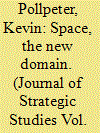

|
|
|
|
|
| Summary/Abstract |
The Chinese military has embarked on a series of organizational and doctrinal reforms intended to better enable it to fight modern war. Prominent among these reforms is the growing emphasis on space to enable long-range precisions strikes and on counterspace to deny space capabilities to an adversary. The People’s Liberation Army (PLA) has officially designated space as a new domain and established an organization to command space forces. With this increased focus on space, the PLA may begin to develop a doctrine to govern the use of space in military operations. The higher priority given to space, especially space control, by the PLA coincides with similar actions by the US military, increasing the possibility of warfare in space and the risks of escalation.
|
|
|
|
|
|
|
|
|
|
|
|
|
|
|
|
| 11 |
ID:
148220
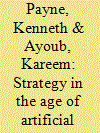

|
|
|
|
|
| Summary/Abstract |
We argue that Artificial Intelligence (AI) will, in the very near future, have a profound impact on the conduct of strategy and will be disruptive of existing power balances. To do so, we review the psychological foundations of strategy and explore the ways in which AI will impact human decision-making. We then review current and evolving capabilities in ‘narrow’, modular AI that is optimised to perform in a particular environment, and explore its military potential. Lastly, we look ahead to the more distant prospect of a general AI.
|
|
|
|
|
|
|
|
|
|
|
|
|
|
|
|
| 12 |
ID:
148215
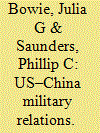

|
|
|
|
|
| Summary/Abstract |
China’s efforts to build a ‘new type of great power relations’ and a ‘new type of military-to-military relations’ do not constitute a major turning point in relations with the United States. Political relations set limits on military cooperation, and the two sides have been unable to construct a sustainable strategic basis for relations. This has contributed to an ‘on-again, off-again’ pattern in military ties. Trends show a pattern of frequent disruptions in military-to-military relations from 2000 to 2010, followed by an increase in interactions beginning in 2012. Nevertheless, obstacles on both sides are likely to limit mutual trust and constrain future development of military-to-military relations.
|
|
|
|
|
|
|
|
|
|
|
|
|
|
|
|
|
|
|
|
|